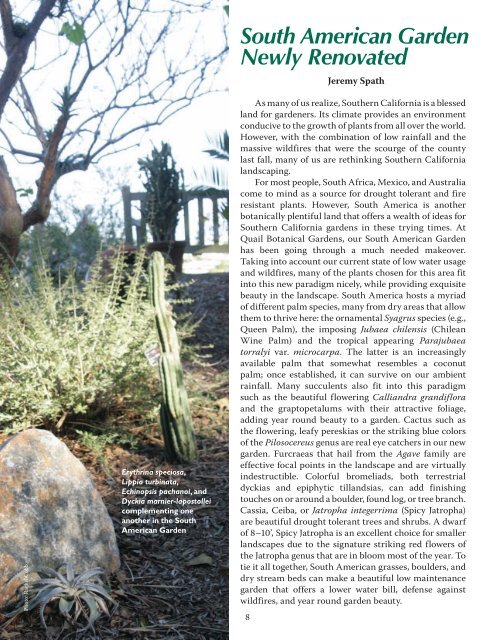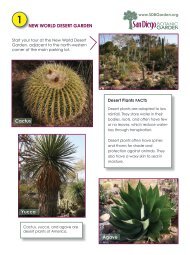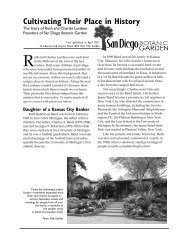Quail Tracks - San Diego Botanic Garden
Quail Tracks - San Diego Botanic Garden
Quail Tracks - San Diego Botanic Garden
Create successful ePaper yourself
Turn your PDF publications into a flip-book with our unique Google optimized e-Paper software.
Photo: Rachel Cobb<br />
Erythrina speciosa,<br />
Lippia turbinata,<br />
Echinopsis pachanoi, and<br />
Dyckia marnier-lapostollei<br />
complementing one<br />
another in the South<br />
American <strong>Garden</strong><br />
South American <strong>Garden</strong><br />
Newly Renovated<br />
As many of us realize, Southern California is a blessed<br />
land for gardeners. Its climate provides an environment<br />
conducive to the growth of plants from all over the world.<br />
However, with the combination of low rainfall and the<br />
massive wildfires that were the scourge of the county<br />
last fall, many of us are rethinking Southern California<br />
landscaping.<br />
For most people, South Africa, Mexico, and Australia<br />
come to mind as a source for drought tolerant and fire<br />
resistant plants. However, South America is another<br />
botanically plentiful land that offers a wealth of ideas for<br />
Southern California gardens in these trying times. At<br />
<strong>Quail</strong> <strong>Botanic</strong>al <strong>Garden</strong>s, our South American <strong>Garden</strong><br />
has been going through a much needed makeover.<br />
Taking into account our current state of low water usage<br />
and wildfires, many of the plants chosen for this area fit<br />
into this new paradigm nicely, while providing exquisite<br />
beauty in the landscape. South America hosts a myriad<br />
of different palm species, many from dry areas that allow<br />
them to thrive here: the ornamental Syagrus species (e.g.,<br />
Queen Palm), the imposing Jubaea chilensis (Chilean<br />
Wine Palm) and the tropical appearing Parajubaea<br />
torralyi var. microcarpa. The latter is an increasingly<br />
available palm that somewhat resembles a coconut<br />
palm; once established, it can survive on our ambient<br />
rainfall. Many succulents also fit into this paradigm<br />
such as the beautiful flowering Calliandra grandiflora<br />
and the graptopetalums with their attractive foliage,<br />
adding year round beauty to a garden. Cactus such as<br />
the flowering, leafy pereskias or the striking blue colors<br />
of the Pilosocereus genus are real eye catchers in our new<br />
garden. Furcraeas that hail from the Agave family are<br />
effective focal points in the landscape and are virtually<br />
indestructible. Colorful bromeliads, both terrestrial<br />
dyckias and epiphytic tillandsias, can add finishing<br />
touches on or around a boulder, found log, or tree branch.<br />
Cassia, Ceiba, or Jatropha integerrima (Spicy Jatropha)<br />
are beautiful drought tolerant trees and shrubs. A dwarf<br />
of 8–10’, Spicy Jatropha is an excellent choice for smaller<br />
landscapes due to the signature striking red flowers of<br />
the Jatropha genus that are in bloom most of the year. To<br />
tie it all together, South American grasses, boulders, and<br />
dry stream beds can make a beautiful low maintenance<br />
garden that offers a lower water bill, defense against<br />
wildfires, and year round garden beauty.<br />
8<br />
Jeremy Spath
















